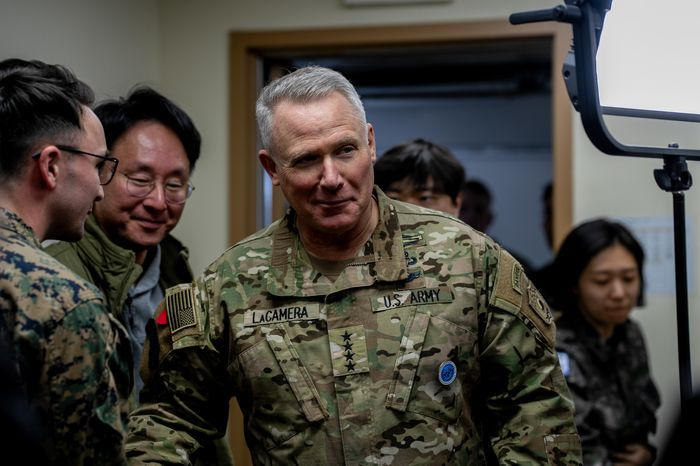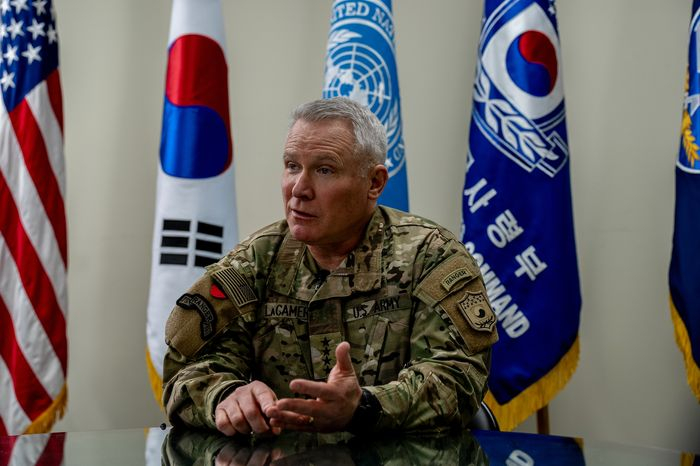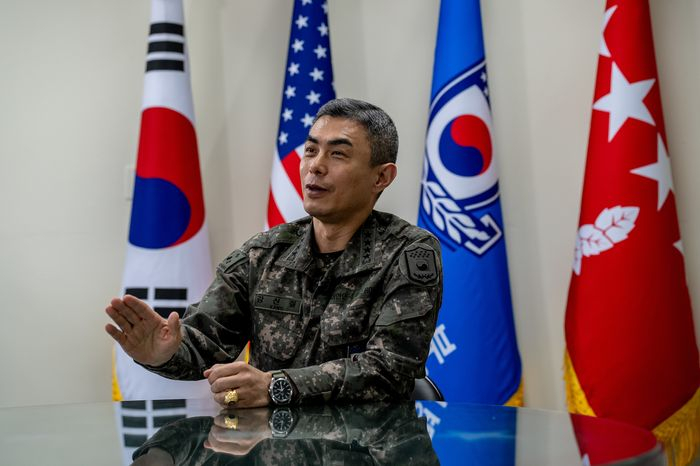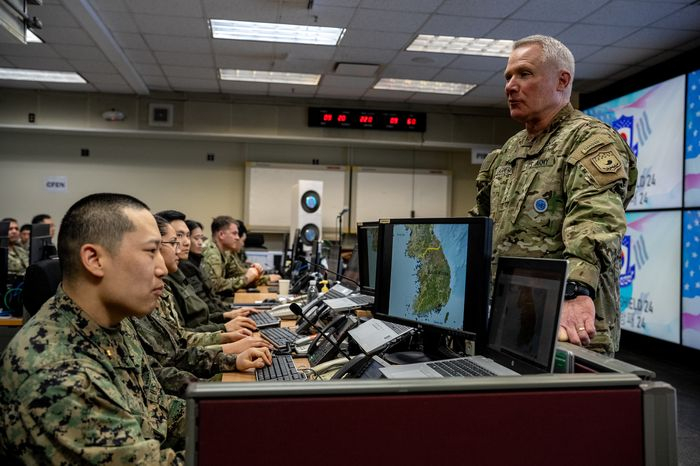Top US general sees changing nuclear threat from North Korea
Head of American forces in South Korea says ‘readiness is perishable,’ as joint exercises double in scale
By The Wall Street Journal Mar 20, 2024 (Gmt+09:00)
LG Chem to sell water filter business to Glenwood PE for $692 million


Kyobo Life poised to buy Japan’s SBI Group-owned savings bank


KT&G eyes overseas M&A after rejecting activist fund's offer


StockX in merger talks with Naver’s online reseller Kream


Mirae Asset to be named Korea Post’s core real estate fund operator



COMMAND POST TANGO, South Korea—The top U.S. military official in South Korea said his thinking has changed on deterring North Korea’s nuclear weapons.
In the past, efforts were dedicated to halting Pyongyang’s development of nuclear capabilities. Now the focus is on preventing Kim Jong Un from using the weapons.
“We have to assure him that positive will be met with positive actions, and negative will be met with negative,” said Gen. Paul J. LaCamera, the four-star general who leads the roughly 28,500 American military personnel stationed in South Korea, in a rare interview.
The stick in that equation is on display this month, as the U.S. and South Korea conduct expanded annual springtime drills. This year, the number of field exercises has roughly doubled, as have participating troops. An unprecedented 12 United Nations Command member states are involved, including France, Canada and the Philippines.
The 11-day training, which ends Thursday, spans land, sea, air, cyber and space operations. The drills practice shooting down North Korean missiles, bombing targets and firing shells.
In an interview at a top-secret bunker complex built underneath a mountain outside Seoul, LaCamera said the exercises are aimed at responding to a vast array of potential threats from Kim’s military. He has urged his soldiers to grab lessons from the wars in Ukraine and the Middle East, as the nature of combat evolves.
“We cannot have a failure of imagination,” the 60-year-old LaCamera said. “It’s just that simple.”
The decades-old wartime bunker is called “Tango”—short for Theater Air Naval Ground Operations—and features a labyrinth of passageways. With exercises under way, U.S. and South Korean soldiers filed through the large underground facility, where packages of Raisin Bran were as plentiful as ramen. The facility is reportedly designed to withstand a tactical nuclear strike.

After becoming a brigadier general more than a decade ago, LaCamera recalled the wording on a coin he possessed back then: Adapt or Perish. Now, he often encourages troops with another quip: “Readiness is perishable.”
Thorny Inter-Korean Tensions
Kim has given officials in Washington and Seoul plenty of reasons recently to prepare for a potential clash.
The North Korean leader has abandoned hopes of peaceful reunification, declared South Korea his country’s No. 1 enemy and vowed to “thoroughly annihilate” Seoul and Washington should either attempt an attack. The 40-year-old dictator has told his people to prepare for war and in recent days oversaw North Korean artillery drills aimed at the enemy’s capital, and the mock takeover of a South Korean border-guard post, state media reported.
Gen. Kang Shin-chul calls North Korea’s weapons a practical, obvious and clear threat. The South Korean four-star general compared the counter strategy to trying to achieve a stalemate in chess. “That’s a metaphor, but we are trying to create a situation where the other side can’t use its nukes,” said Kang, the deputy commander general for the South Korea-U.S. Combined Forces Command, which directs both countries’ troops in the event of war.

The command has operational control of more than 600,000 active-duty military personnel from both countries, plus more than 3.5 million South Korean reservists. “If North Korea provokes, we can be stronger and subdue them completely,” Kang said.
South Korean President Yoon Suk Yeol, a conservative who backs a tough line with the North, says peace is built through strength. He has vowed that Seoul’s response to any Pyongyang provocation would be multiple times as hard.
The elevated tension between the two Koreas goes beyond tough words. They each in recent months have launched spy satellites into space. In January, the two countries exchanged live-fire drills, one after another. A years-old inter-Korean accord that was meant to tone down military hostilities has been ripped up, resulting in border soldiers on both sides carrying arms once again.
The South Korean emphasis on a disproportionate response to any North Korean provocation does raise some concern for the U.S., which may not want to see a limited attack escalate into a broader conflict, said Ankit Panda, the Stanton senior fellow in the nuclear-policy program at the Carnegie Endowment for International Peace. Hashing out what might be an acceptable response for all scenarios remains a work in progress for Washington and Seoul, he added.
“I do think there is some daylight here between the two countries,” Panda said.

Pyongyang’s antagonism toward Seoul aims to weaken what is a concern for Kim: the Yoon administration’s bolstered three-way military ties with the U.S. and Japan, which provide a unified front against North Korea, said Sydney A. Seiler, a former U.S. national intelligence officer for North Korea.
“If South Korea looks like they’re shooting off for revenge, and not coordinating with the U.S., it can actually do more harm than good,” said Seiler, a senior adviser of the Korea Chair at the Center for Strategic and International Studies, a Washington, D.C.-based think tank.
A fair fight?
Both LaCamera and Kang said their countries remain aligned and focused on sharpening readiness to dissuade Kim from bad behavior.
North Korea has advanced its nuclear and weapons capabilities with impunity in recent years. The regime has unveiled new generations of its intercontinental ballistic missiles, which have the range to strike the U.S. mainland. Pyongyang has sharpened regional attack power that threatens Tokyo, Seoul and the soldiers under LaCamera’s direction. Those efforts include recent tests of cruise missiles that the Kim regime claims are nuclear-capable.
LaCamera grew circumspect when asked where Kim might instigate an inter-Korean clash. “I focus on capabilities,” he said. “If I could read minds, I would be in a different business.”
Regarding Kim’s fledgling relationship with Russian President Vladimir Putin, LaCamera opted for a more maximalist presumption of what the two countries might be up to, in terms of how North Korea’s military capabilities might be improving with Russian assistance. But he declined to go into specifics.
Regardless of North Korea’s advancements, LaCamera said: “I’m not looking for a fair fight.”
Write to Timothy W Martin at Timothy.Martin@wsj.com
-
 North KoreaWhile the World Was Looking Elsewhere, North Korea Became a Bigger Threat
North KoreaWhile the World Was Looking Elsewhere, North Korea Became a Bigger ThreatFeb 27, 2024 (Gmt+09:00)
long read -
 North KoreaNorth Korea’s missiles tested on the battlefields of Ukraine
North KoreaNorth Korea’s missiles tested on the battlefields of UkraineJan 23, 2024 (Gmt+09:00)
6 Min read -
 North KoreaNorth Korea Launches Suspected Spy Satellite After Two Botched Tries
North KoreaNorth Korea Launches Suspected Spy Satellite After Two Botched TriesNov 22, 2023 (Gmt+09:00)
4 Min read -
 Business & PoliticsRussia Pushes Security Talks With North Korea, China
Business & PoliticsRussia Pushes Security Talks With North Korea, ChinaOct 26, 2023 (Gmt+09:00)
4 Min read -
 North KoreaChina Appears to Have Repatriated North Koreans Despite International Pressure
North KoreaChina Appears to Have Repatriated North Koreans Despite International PressureOct 17, 2023 (Gmt+09:00)
4 Min read -
 Business & PoliticsNorth Korea’s Kim Jong Un Expected to Meet Putin in Russia
Business & PoliticsNorth Korea’s Kim Jong Un Expected to Meet Putin in RussiaSep 05, 2023 (Gmt+09:00)
2 Min read


